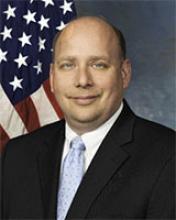Durable, stable ceramic materials for propulsion systems operating in austere environments
Date & Time:
Fri, 04/16/2021 - 2:00pmSpeaker:
Michael WalockAffiliation:
Army Research LaboratoryLocation:
ZOOM: Register to be invitedAbstract:
Army aviation needs equipment that can operate in any part of the world without loss of performance. Previous operations in austere environments have resulted in aircraft incidents and loss of life due to particulate ingestion into the engine. As particulates travel through the engine and enter the hot-section, they undergo a phase change and melt in the combustor. These molten particulates imping upon the hot-section components and deposit as a glassy calcia-magnesia-alumina-silicates (CMAS) which leads to rapid performance degradation by clogging air pathways in the engine.
To mitigate the damage caused by molten particulates, CCDC - ARL has a robust program to develop sandphobic thermal/environmental barrier coatings (T/EBCs) for gas turbine applications. To this end, we have developed a novel, composite thermal barrier coating (TBC) consisting of yttria-stabilized zirconia (YSZ) blended with gadolinia. The proposed composition combines the excellent thermo-mechanical properties of YSZ together with the CMAS resistance of rare earth oxides. The presence of gadolinia in the composite coating reduced the adhesion of the CMAS and at 32 vol.% gadolinia addition, the CMAS was completely delaminated. In addition to TBC development, we have also investigated high-entropy oxides and rare-earth-hafnia compounds for potential use as environmental barrier coatings to protect Si-based ceramic matrix composites. Further work, supported by a SERDP funded project, will continue to explore innovative coatings as a means to protect hot section components.

Biography:
Dr. Michael Walock currently serves as the Chief (A) of the Metals Branch within the Weapons and Materials Research Directorate (WMRD) of the US Army Combat Capabilities Development Command (DEVCOM) - Army Research Laboratory (ARL). Prior to this, he was a Research Physicist within the Vehicle Technology Directorate (VTD).
He joined DEVCOM - ARL as a Post-doctoral Fellow in December 2014 and was subsequently hired as a government employee in July 2016. During this time, he has designed and developed a unique button cell flame testing rig for rapid prototyping of advanced high temperature materials and engine components; assisted with the conversion of an atmospheric jet burner rig to a hot particulate ingestion rig; investigated structure-property relationships of sand-glazed engine components; and helped develop the methodology necessary to elucidate the fundamental thermal-chemical-mechanical phenomena occurring within an engine subjected to sand ingestion.
Prior to joining VTD, Dr. Walock worked at the University of Alabama at Birmingham (Birmingham, AL) where he conducted surface science research on catalytic nanoparticles, inorganic nanofibers, and carbon nanofibers. In addition, he also taught entry-level physics as a Lecturer at Blinn College (Bryan, TX) and the University of Alabama at Birmingham. During his doctoral research, Dr. Walock was the inaugural student in a dual-degree program between the University of Alabama at Birmingham (UAB) and Arts et Metiers ParisTech (AMP) in France. This collaboration on hard coatings for wood-cutting tools resulted in several publications and a dual doctorate-level degree from UAB and AMP. Dr. Walock also has expertise in magnetic thin films from his master's research at The University of Alabama.
Dr. Walock is also a veteran of the US Army, where he served in multiple logistics, operations, and training roles for both US Army Reserves and Army National Guard units. In NOV 2004, he deployed with the 278 Chemical Battalion (Alabama Army National Guard) to Afghanistan where he served as an operations planner in the Battalion Tactical Operations Center.
Seminar ID:
202104161400Department:
Materials Science and Engineering